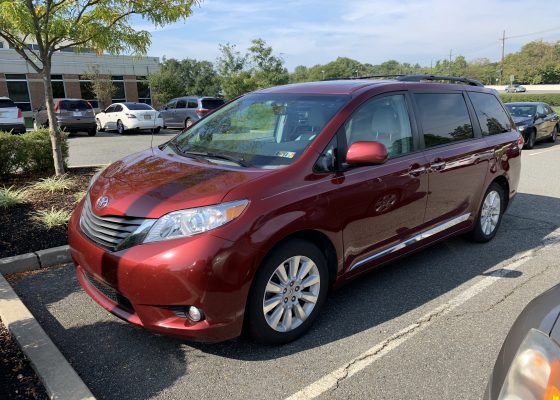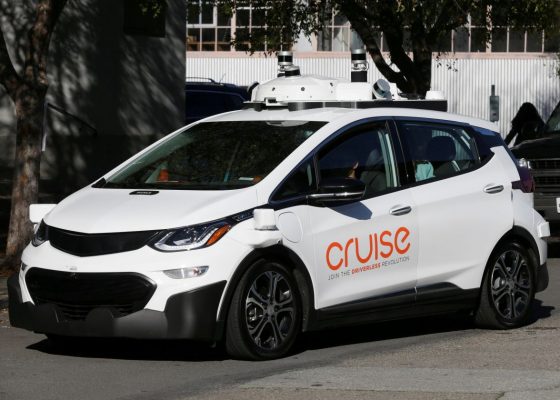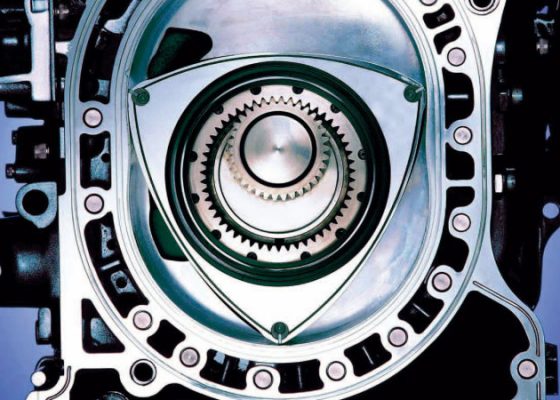Review: 2011 Mitsubishi Outlander Sport SE AWC
By Chris Haak
When I was growing up, I always thought the word “express” meant “fast.” But then a few years ago, I had a colleague with a different theory on what the word meant. “When did ‘express’ get a new definition that means ‘same thing, only smaller? Holiday Inn Express: same thing, only smaller. Pizza Hut Express: same thing, only smaller.”
 Instead of applying the word “Express” to its crossovers to mean “same thing, only smaller,” Mitsubishi instead applies the “Sport” nomenclature. Whereas in the context of nearly any other vehicle “sport” might mean a model that is faster, handles better, or at least looks like it is faster or handles better, Mitsubishi created the Montero Sport in the 1990s as a new model that’s “the same thing, only smaller” of its Montero SUV, and now has created a smaller Outlander called – you guessed it – the Outlander Sport. And it’s very much built using the “same thign, only smalller” template.
Instead of applying the word “Express” to its crossovers to mean “same thing, only smaller,” Mitsubishi instead applies the “Sport” nomenclature. Whereas in the context of nearly any other vehicle “sport” might mean a model that is faster, handles better, or at least looks like it is faster or handles better, Mitsubishi created the Montero Sport in the 1990s as a new model that’s “the same thing, only smaller” of its Montero SUV, and now has created a smaller Outlander called – you guessed it – the Outlander Sport. And it’s very much built using the “same thign, only smalller” template.
Generally, the smaller a particular vehicle is, you’ll find more hard plastic and cheap interior materials, and fewer available features. However, because the Outlander Sport is newer than the Outlander (the former being an all-new model for 2011, and the latter having been on the US market since the 2007 model year), the Outlander Sport enjoys the benefit of newer technology and the trend toward improving interior materials and shapes. The regular Outlander, while it’s been upgraded a bit since its launch, is starting to show its age both in its shape and in its interior quality.
 Outside, the Outlander Sport is clearly related to the larger Outlander, and maintains a strong family resemblance with other Mitsubishi products, and in particular, the Lancer on which it’s based. But being a newer design, the Sport has forsaken some of the odd shapes and curves that other Mitsubishi products, including the Outlander, have. When looking at the Outlander Sport next to an Outlander, it’s obvious where the length was removed to create the Outlander Sport: on the ends. The front overhang appears to be a bit shorter in the Sport, and the rear overhang is dramatically reduced, since the Outlander Sport does not need to fit a third row seat in its cargo area.
Outside, the Outlander Sport is clearly related to the larger Outlander, and maintains a strong family resemblance with other Mitsubishi products, and in particular, the Lancer on which it’s based. But being a newer design, the Sport has forsaken some of the odd shapes and curves that other Mitsubishi products, including the Outlander, have. When looking at the Outlander Sport next to an Outlander, it’s obvious where the length was removed to create the Outlander Sport: on the ends. The front overhang appears to be a bit shorter in the Sport, and the rear overhang is dramatically reduced, since the Outlander Sport does not need to fit a third row seat in its cargo area.
 While sharing the same 105.1 inch wheelbase, the Sport is a sizable 18.6 inches shorter than the regular Outlander. The result is much tidier proportions and nearly identical passenger-room measurements in the first and second row seats and a 275-pound weight loss. The only downside of the nip-tuck, other than losing the third row, is that rear cargo volume suffers. The Outlander has 36.2 cubic feet of cargo space with the third row folded and 49.5 cubic feet with both rear seats folded. The Outlander Sport has 21.7 cubic feet behind the second row and 49.5 cubic feet with the rear seat folded. Still, 21.7 cubic feet isn’t really anything to sneeze at. Sedans would kill for that kind of cargo volume.
While sharing the same 105.1 inch wheelbase, the Sport is a sizable 18.6 inches shorter than the regular Outlander. The result is much tidier proportions and nearly identical passenger-room measurements in the first and second row seats and a 275-pound weight loss. The only downside of the nip-tuck, other than losing the third row, is that rear cargo volume suffers. The Outlander has 36.2 cubic feet of cargo space with the third row folded and 49.5 cubic feet with both rear seats folded. The Outlander Sport has 21.7 cubic feet behind the second row and 49.5 cubic feet with the rear seat folded. Still, 21.7 cubic feet isn’t really anything to sneeze at. Sedans would kill for that kind of cargo volume.
 The interior design is clean and functional, with better material quality and fit-and-finish than I’ve found in the two Outlanders that I’ve reviewed over the years. Though there’s still plenty of hard plastic to go around, the upper dash is soft to the touch, and the door panels and armrest are padded in all the right spots.
The interior design is clean and functional, with better material quality and fit-and-finish than I’ve found in the two Outlanders that I’ve reviewed over the years. Though there’s still plenty of hard plastic to go around, the upper dash is soft to the touch, and the door panels and armrest are padded in all the right spots.
My tester was equipped with the optional Premium Package, which costs $1,800 and throws in a panoramic glass roof and a 710-watt Rockford-Fosgate premium sound system including subwoofer and Sirius satellite radio, but curiously does not include leather. It also had the $2,000 Navigation/Rearview Camera.
 The panoramic roof was a neat feature, which almost gives the sensation of driving a convertible, but without the noise. The glass roof, which doesn’t open, is huge and covers both front and rear seats. I’m a huge proponent of glass roofs because of the feeling of airiness that they impart on even the darkest interior – and rarely open the moonroof in my own car – but the sheer size of the Outlander Sport’s roof means that on sunny days a LOT of daylight makes its way inside the small crossover. There’s a power opaque sunshade that effectively blocks out all sunlight if that’s how you roll. At night, there are gold LED accent lights along the sides of the glass roof that remind one of a tacky early-1990s style restaurant’s decor. Those lights may be dimmed or turned off via a switch on the dash.
The panoramic roof was a neat feature, which almost gives the sensation of driving a convertible, but without the noise. The glass roof, which doesn’t open, is huge and covers both front and rear seats. I’m a huge proponent of glass roofs because of the feeling of airiness that they impart on even the darkest interior – and rarely open the moonroof in my own car – but the sheer size of the Outlander Sport’s roof means that on sunny days a LOT of daylight makes its way inside the small crossover. There’s a power opaque sunshade that effectively blocks out all sunlight if that’s how you roll. At night, there are gold LED accent lights along the sides of the glass roof that remind one of a tacky early-1990s style restaurant’s decor. Those lights may be dimmed or turned off via a switch on the dash.
 Of note, you can’t get the navigation system without purchasing the Premium Package. This means that to step from a base Outlander Sport SE to one with navigation, you have to fork over a hefty $3,800, and get a large glass roof, which you may or may not want. The navigation system was reasonably easy to use, and its touchscreen was also fairly responsive. Having used a smartphone for years, I look forward to the day when vehicle navigation screens use capacitive touchscreens rather than the old-fashioned resistive touchscreens are employed in cars today, because the capacitive touchscreen experience is far superior – as long as you’re not wearing gloves.
Of note, you can’t get the navigation system without purchasing the Premium Package. This means that to step from a base Outlander Sport SE to one with navigation, you have to fork over a hefty $3,800, and get a large glass roof, which you may or may not want. The navigation system was reasonably easy to use, and its touchscreen was also fairly responsive. Having used a smartphone for years, I look forward to the day when vehicle navigation screens use capacitive touchscreens rather than the old-fashioned resistive touchscreens are employed in cars today, because the capacitive touchscreen experience is far superior – as long as you’re not wearing gloves.
The Outlander Sport drives quite like you’d expect a tall, slightly larger and heavier Lancer would. That is, it’s reasonably buttoned-down with little body roll. Steering is light and accurate, and the brakes, though they don’t have much initial bite, can bring the 3,300 pound  crossover to a stop in a drama-free way. The Outlander Sport’s suspension tuning is dialed in more toward the firm side of the spectrum, and there isn’t much compliance over bumps. That firmness helps control body roll, but a family-hauling crossover may be better served by more compliant suspension, or at least the option to choose it. The Outlander Sport SE’s 18 inch wheels look great, but aren’t doing the ride any favors.
crossover to a stop in a drama-free way. The Outlander Sport’s suspension tuning is dialed in more toward the firm side of the spectrum, and there isn’t much compliance over bumps. That firmness helps control body roll, but a family-hauling crossover may be better served by more compliant suspension, or at least the option to choose it. The Outlander Sport SE’s 18 inch wheels look great, but aren’t doing the ride any favors.
Under the shapely hood, you’ll find a single engine choice: a 2.0 liter four cylinder rated at 148 horsepower. That’s not a lot of power today (my high school chariot 20 years ago, a (ahem) 1988 Grand Am SE’s 2.3 liter Quad 4 had a 150-horsepower rating, and the Grand Am was some 500 pounds lighter than the Outlander Sport. The two-point-slow (actually, its 148 horsepower number isn’t bad considering its displacement) does give a respectable 24 MPG in the city and 29 MPG on the highway, according to the EPA. According to the Outlander Sport’s trip computer, I got about 25 MPG combined, which is in line with my past experience of my driving habits relative to the EPA ratings.
 Coupled to the four-banger is a paddle-shifted CVT. I’m not a fan of CVTs because of the unnatural sounds and sensations that they deliver, and the installation in the Outlander Sport is no exception. The benefit, of course, is that it’s always in the “right” gear for conditions, at least theoretically. Under hard acceleration (if a roughly 10-second zero to sixty time can be considered “hard” under any circumstances), the CVT keeps the little engine in the thick of its very high powerband, and under more leisurely driving, spins the engine only as much as is necessary to maintain momentum. There are magnesium paddle shifters nestled behind the steering wheel, and they elicit an immediate (fake) shift, but they’re kind of pointless in the whole scheme of things.
Coupled to the four-banger is a paddle-shifted CVT. I’m not a fan of CVTs because of the unnatural sounds and sensations that they deliver, and the installation in the Outlander Sport is no exception. The benefit, of course, is that it’s always in the “right” gear for conditions, at least theoretically. Under hard acceleration (if a roughly 10-second zero to sixty time can be considered “hard” under any circumstances), the CVT keeps the little engine in the thick of its very high powerband, and under more leisurely driving, spins the engine only as much as is necessary to maintain momentum. There are magnesium paddle shifters nestled behind the steering wheel, and they elicit an immediate (fake) shift, but they’re kind of pointless in the whole scheme of things.
The engine’s low output notwithstanding, it actually is possible to spin the tires under heavier throttle application from a standing start if the Outlander Sport is in front wheel drive mode. That’s easily remedied via the AWC knob on the center console, which offers FWD, automatic 4WD, and locked 4WD modes. Aside from a few rainy days, I didn’t have the opportunity to test the Outlander Sport in true adverse conditions that would really necessitate all wheel drive use, but I did use the automatic AWD feature when driving in hard rain for additional peace of mind.
Base MSRP for the Outlander Sport SE AWC is $22,995 plus a $780 destination charge. My tester had two expensive options, the $1,800 Premium Package and the $2,000 Navigation/Rear Camera package, bringing its total MSRP to $27,575. That might sound like a pretty sizable chunk of change for the smallest of Mitsubishi crossovers, but it’s some $3,000 less expensive than a CR-V on a feature-adjusted comparision according to TrueDelta.com. It also happens to be the highest-quality interior of any Mitsubishi product sold in the US. If the Outlander had the CR-V’s 180-horsepower four cylinder and a tad more refinement in ride/handling, it just might sway more buy


